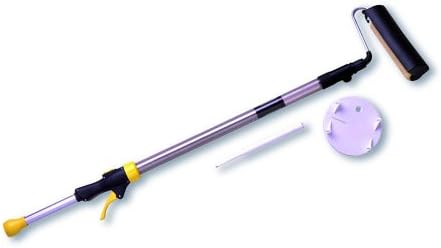Amethyst
Give me a museum and I'll fill it. (Picasso) Give me a forum ...
- Joined
- Dec 21, 2008
- Messages
- 12,668
As mentioned in another thread, we'll be painting our home's interior this summer. All our painting supplies were left behind when we moved, so we need to put together a suite of quality, compatible painting tools and equipment that won't break the bank. For example, we want roller cages, roller covers, and extension poles to work together, even if they are not all the same maker.
The large number of DIY painter advice sites is making choice a little difficult, so I thought I'd turn to some of the most confident and detail-minded DIYers I know: the ER gang.
Besides the dark-brown and dark-blue rooms, the rest of the house has white walls, rather marked up and full of picture hanging holes. No major drywall damage that we've observed, although sometimes the painting process causes you to find defects you did not see before, especially given 10-foot ceilings.
We probably won't paint the ceilings.
We plan to paint the whole interior a light cream color, using Sherwin-Williams primer (for the dark colors) and flat wall paint.
Here is what we think our "suite" should contain:
1. Extension poles: 2-4', 4-8'
2. Roller cages that will fit the extension poles
3. Roller covers, suitable for flat or eggshell paint on previously painted drywall. Roller covers obviously must be compatible with 2 and 3.
4. Roller pans or similar system for transporting paint onto the roller and around the rooms
5. Drop cloths
6. Cutting-in tools
7. Spackle and drywall compound
8. Sand paper
9. Painter's tape
Stepladder: We have a sturdy 8-foot aluminum step ladder, which lacks a painter's platform or hangers for paint buckets. Not sure we want to spend for a specialized painter's ladder.
Have I missed anything essential? We're open to new ideas, with one exception: No paint sprayers. No disrespect to those who love sprayers; we just don't want to use our home as "practice."
Thanks!
Amethyst
The large number of DIY painter advice sites is making choice a little difficult, so I thought I'd turn to some of the most confident and detail-minded DIYers I know: the ER gang.
Besides the dark-brown and dark-blue rooms, the rest of the house has white walls, rather marked up and full of picture hanging holes. No major drywall damage that we've observed, although sometimes the painting process causes you to find defects you did not see before, especially given 10-foot ceilings.
We probably won't paint the ceilings.
We plan to paint the whole interior a light cream color, using Sherwin-Williams primer (for the dark colors) and flat wall paint.
Here is what we think our "suite" should contain:
1. Extension poles: 2-4', 4-8'
2. Roller cages that will fit the extension poles
3. Roller covers, suitable for flat or eggshell paint on previously painted drywall. Roller covers obviously must be compatible with 2 and 3.
4. Roller pans or similar system for transporting paint onto the roller and around the rooms
5. Drop cloths
6. Cutting-in tools
7. Spackle and drywall compound
8. Sand paper
9. Painter's tape
Stepladder: We have a sturdy 8-foot aluminum step ladder, which lacks a painter's platform or hangers for paint buckets. Not sure we want to spend for a specialized painter's ladder.
Have I missed anything essential? We're open to new ideas, with one exception: No paint sprayers. No disrespect to those who love sprayers; we just don't want to use our home as "practice."
Thanks!
Amethyst

